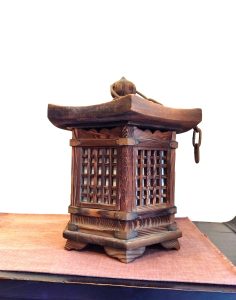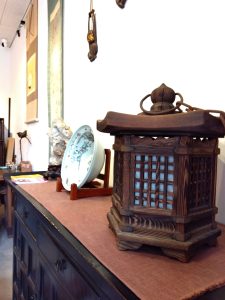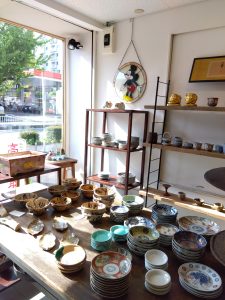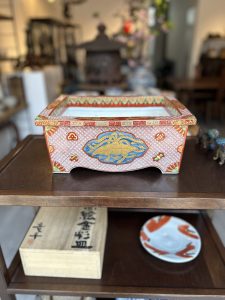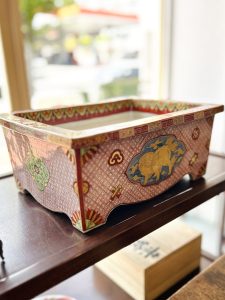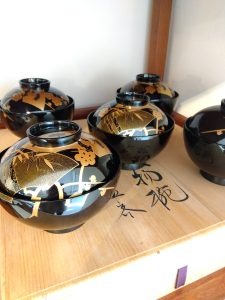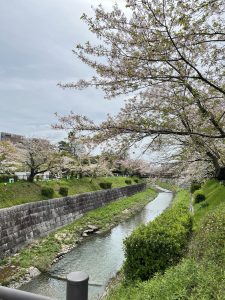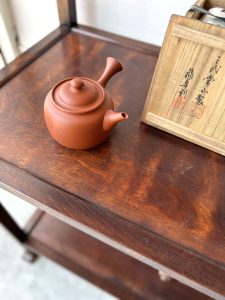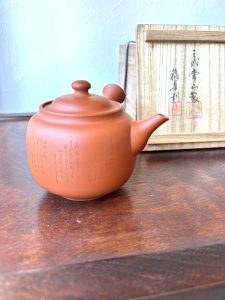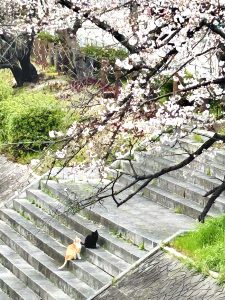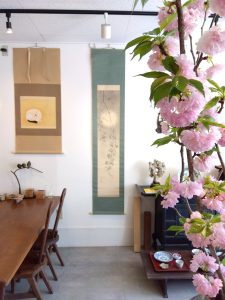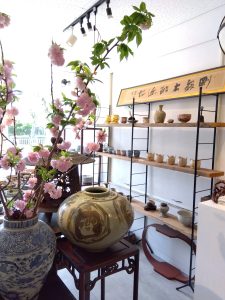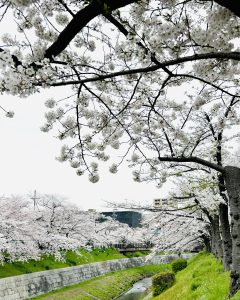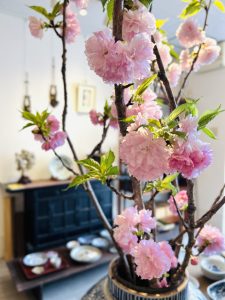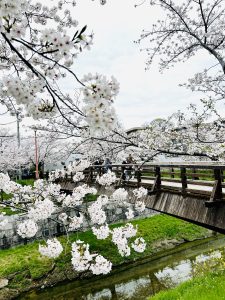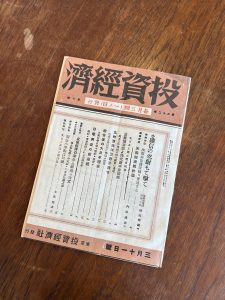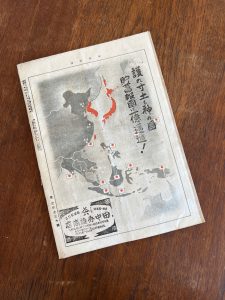遊び心は大切です(愛知県名古屋市千種区姫池通 骨董品買取 古美術風光舎)
2024.04.17
みなさまこんにちは。スタッフHでございます。
明日4月18日(木)10:00~ 17:00 持込鑑定会を開催いたします。
どのくらいの価値があるのか気になるお品がございましたら、査定だけでも構いませんので、ご都合の良い時間にお気軽にお立ち寄りください。お待ちしております。
さてご縁があり、風光舎に清水公照氏の作品が多数仲間入りしております。東大寺別当・華厳宗管長などを務め、宗教家から美術家へと活動の場を広げられた方です。
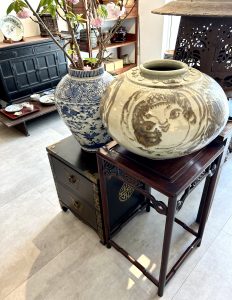
絵画、陶芸、書を中心に多数の作品を制作し、独特の味わいある作風で知られています。
陶土で手びねりにより作られた羅漢や不動、観音像などの「泥仏(どろぼとけ)」と名づけられた仏像は飄々とした愛嬌があり愛され続けています。30年以上かけて全国の窯元を訪ね、10000体を超える泥仏を制作したといわれています。風光舎に並んでいる作品に描かれているお顔もどれも愛らしく、一つずつ眺めるのが楽しいです。
「煩悩のない人間などいない」「悩みに悩みぬいた時に出る心の汗が自分の人生を清めてくれる」という公照氏の言葉通り、泥仏の姿はとても人間味あふれるものとなっています。
また本格的に書を学ぶきっかけとなったのは、中国で漢字文化に直接触れる機会があったからだそうです。唐時代の書家の作品を手本に楷書体や草書体を学び、寺門の額や茶掛けなどを書き続けるうちにおおらかで奔放な独自の書風となっていきました。
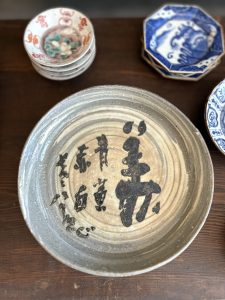
簡単にご経歴をご紹介させていただきますと、16歳で東大寺塔頭宝厳院の清水公俊氏の下に入寺し、これ以降清水公照と名乗るようになります。龍谷大学で華厳宗を学んだのち、天龍寺で禅を学びばれました。
戦時中は中国へ出征し、帰還すると35歳で東大寺塔頭宝厳院の住職となります。翌年、今日の東大寺学園中学校・高等学校の前身となる菁々中学を創設し校長となり、書道教師も兼任していたとのこと。生徒からのあだ名は‘ネギ坊主’だったとか。「昭和の良寛」と親しまれた公照氏の大らかな人柄が想像できます。また52歳になる頃には東大寺幼稚園と女子学園園長に就任し学校教育に貢献しました。
この時の園児との触れ合いが公照氏の後半生に大きな影響を与えたといわれています。園児の自由な発想に刺激を受けて陶芸や書画を始め、その自由奔放な作風で描き続けた絵巻日記や泥仏などが多数残されています。常に遊び心を忘れず、精力的に活動されていたそうです。まさに子供のような好奇心を持ち続けていらっしゃったのかもしれませんね。
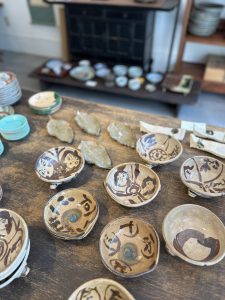
その後、100年に一度といわれる東大寺大仏殿、昭和大修理の総指揮を執り無事に成功させました。落慶法要の当日は、前日の台風がうそのように晴れ渡り、大仏殿の鴟尾(しび)が金色に輝いたと伝えられています。
僧侶、美術家、教育者といくつもの顔をお持ちになり活躍されていました。元々多才な方だったのでしょうが、何事も柔軟に受け入れ、行動に移すフットワークの軽さを感じます。
私の友人の中には、周囲の目を気にし過ぎず、やりたい、面白そうと思う方へ躊躇なく突き進む人たちがいます。先日久しぶりに会う機会があり、数年分の元気をもらいました。
清水公照氏もご自身の大らかで奔放な作品と同様に、周囲の人にエネルギーを与える方だったのではないでしょうか。
それでは、また次の機会に。
Hello everyone. This is Staff H.
Tomorrow, Thursday, April 18, from 10:00 a.m., we will be holding an appraisal session.
If you have any items of value that you are interested in, please feel free to stop by at your convenient time, even if it is just for an appraisal. We look forward to seeing you.
By the way, many works by Kosho Shimizu have joined the Fukosha. He served as the Bettou of Todaiji Temple and the chief abbot of the Kegon sect of Buddhism, and expanded his activities from a religious leader to an artist.
He is known for his unique and tasteful style of painting, ceramics, and calligraphy.
He is known for his unique and tasteful style. Each of the faces depicted in the Fukosha works are adorable, and it is a pleasure to look at them one by one.
As he said, “There is no such thing as a person without troubles,” and “The sweat of the heart that comes out when you are troubled by troubles purifies your life.
What inspired him to study calligraphy in earnest was the opportunity to come into direct contact with Chinese character culture in China. He learned the standard and cursive styles of calligraphy from the works of Tang Dynasty calligraphers, and as he continued to write on temple gate frames and tea hangings, he developed his own unique style of calligraphy that is both generous and uninhibited.
At the age of 16, he entered the temple of Todaiji’s pagoda, Hogonin, under the name of Shimizu Kosho, and thereafter took on the name Shimizu Kosho. After studying Kegon Buddhism at Ryukoku University, he studied Zen at Tenryuji Temple.
During the war, he went to China, and upon his return, at the age of 35, he became the abbot of Hogonin, the pagoda of Todaiji Temple. The following year, he founded and became the principal of Jingenshu Junior High School, the predecessor of today’s Todaiji Gakuen Junior and Senior High Schools, where he also served as a calligraphy teacher. He was also a calligraphy teacher. His students nicknamed him “Negibozu,” or “green onion boy. We can imagine the magnanimous personality of Kosho, who was affectionately known as the “Ryokan of the Showa era. At the age of 52, he was appointed to extend the Todaiji Kindergarten and the Girls’ Academy, contributing to school education.
It is said that his interactions with the children had a great influence on the latter half of his life. The children’s free-spirited ideas inspired him to take up pottery, calligraphy, and painting, and he left behind many picture scroll diaries and mud Buddhas that he continued to draw in his free-spirited style. He was always playful and energetic. Perhaps it was his childlike curiosity that kept him going.
Later, he took overall command of the Showa era Great Repair of the Great Buddha Hall of Todaiji Temple, which is said to be completed only once every 100 years, and successfully completed it. It is said that on the day of the Rakkei Buddhist memorial service, the weather cleared up as if a typhoon had occurred the day before, and the shibi of the Great Buddha Hall shone with a golden color.
He was active as a monk, artist, and educator. He may have been a man of many talents to begin with, but I feel that he was flexible in accepting anything and light in his footwork to take action.
Among my friends, there are people who do not care too much about what others think, but go ahead without hesitation to do what they want to do or what they think is interesting. The other day I had a chance to see them for the first time in a while, and they gave me several years’ worth of energy.
I believe that Mr. Kosho Shimizu was a person who gave energy to those around him, just like his own generous and uninhibited works.
I will see you next time.
*******************
ご実家の整理やお片付けなどをされている方のご相談などが多くございます。
お片付けなどくれぐれもご無理のないようになさってくださいませ。
風光舎では古美術品や骨董品の他にも絵画や宝石、趣味のお品など様々なジャンルのものを買受しております。
お片付けをされていて、こういうものでもいいのかしらと迷われているものでも、どうぞお気軽にご相談下さいませ。
また風光舎は、出張買取も強化しております。ご近所はもちろん、愛知県内、岐阜県、三重県その他の県へも出張いたします。
まずは、お電話お待ちしております。
愛知県名古屋市千種区姫池通
骨董 買取【古美術 風光舎 名古屋店】
TEL052(734)8444
10:00-18:00 OPEN

